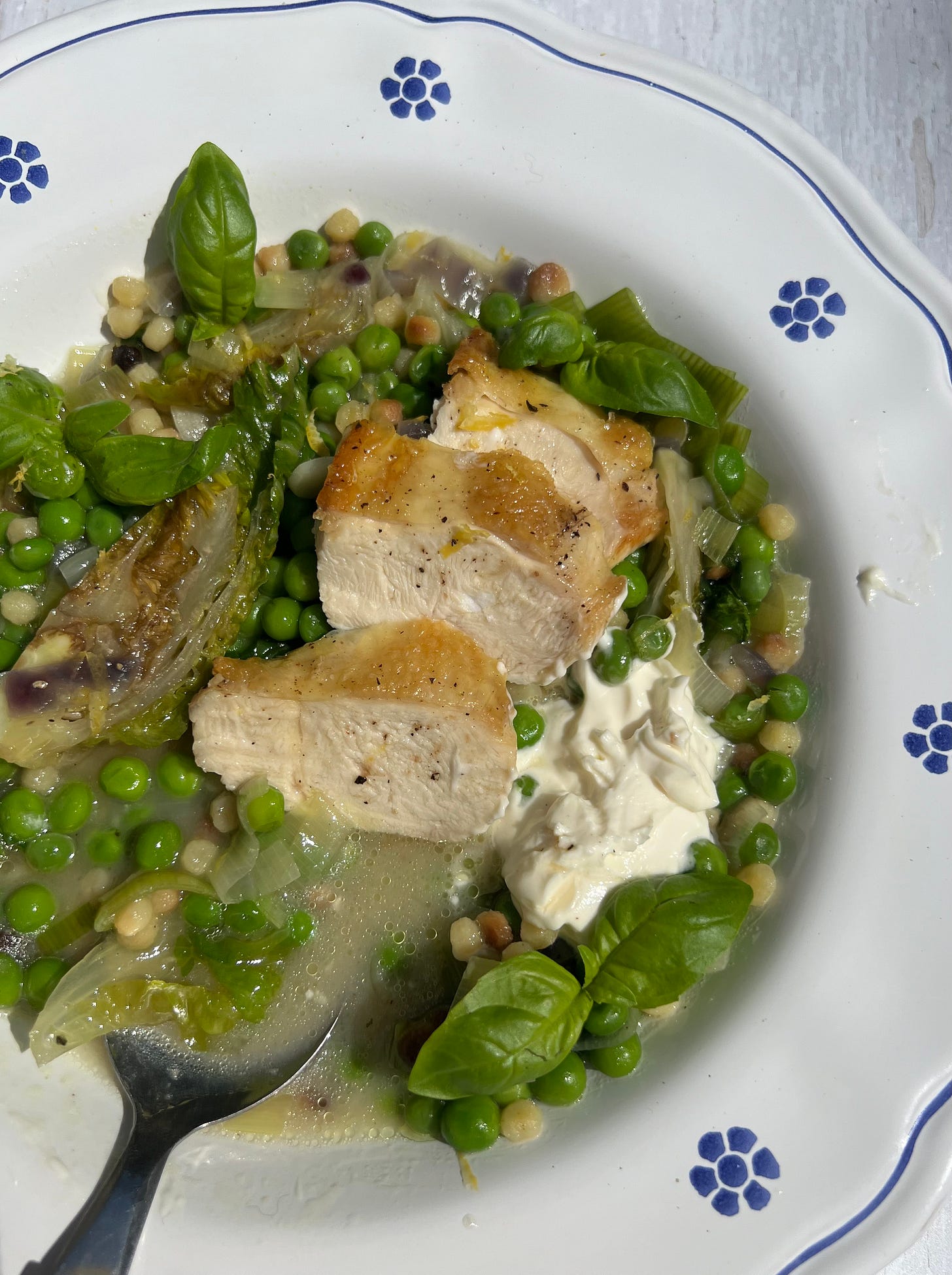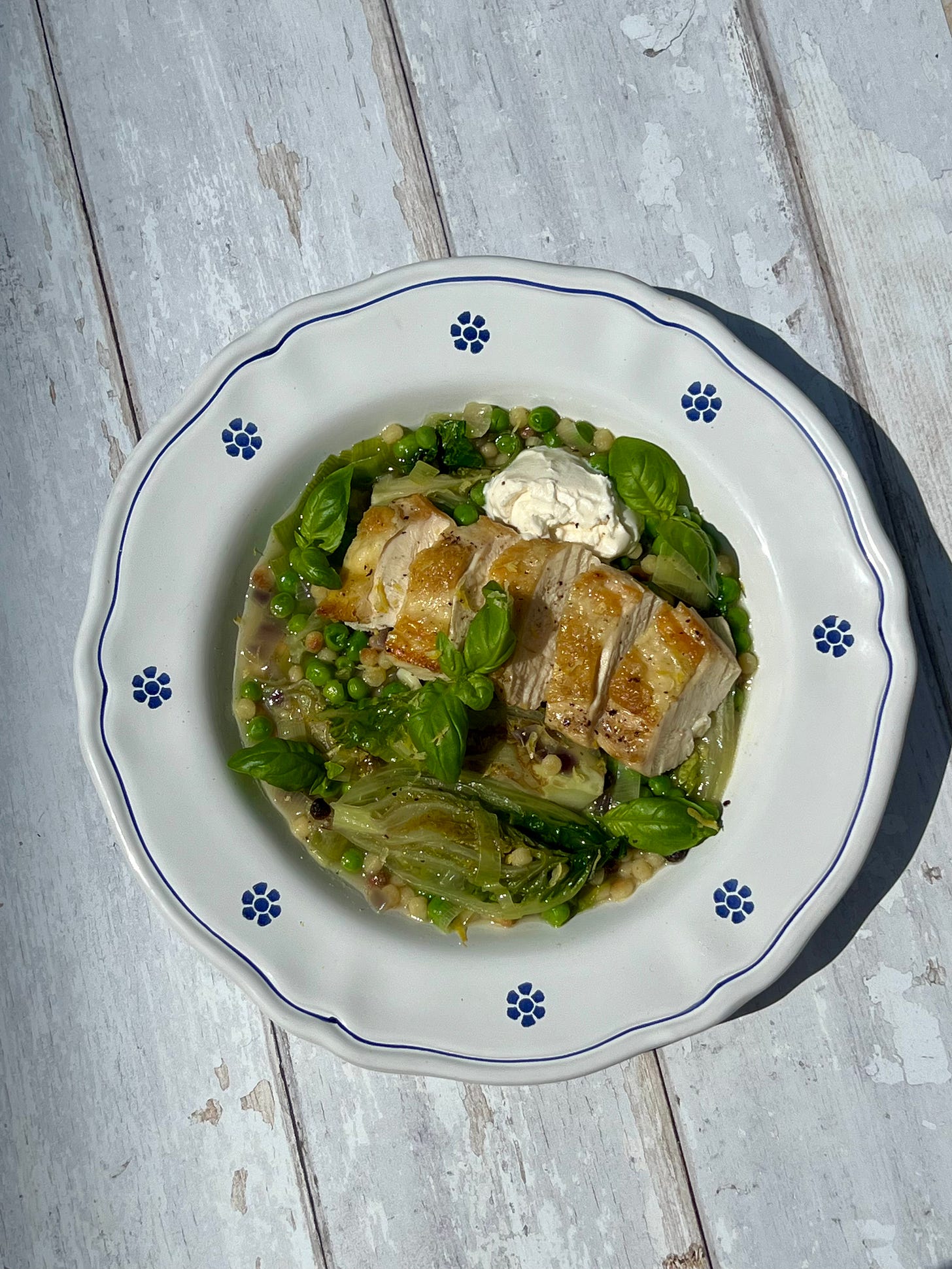If you haven’t tried cooking your little gem lettuces, well I don’t know what to tell you other than you are in for a treat. I thought it was such a strange concept the first time I had lettuce and pea soup but it really truly blew me away. It works so well when cooked - and soaks up all the delicious flavour of the broth it’s cooked in. It’s really so good. This is such a light and delicate dish - worthy of a restaurant and honestly so easy. I say it’s light and delicate, which it is but it’s one of those brilliant dishes that’s still satisfying and comforting.
Sometimes called Sardinian couscous, fregola lands somewhere between a grain and a pasta, with a nutty flavor and irregular texture that's all its own. It’s made from hard durum wheat flour - rolled, sun-dried, and toasted to a mix of shades of yellow, gold, and brown. You could also use orzo in this recipe or giant cous cous would work too but try to get fregola if you can, I find I reach for it in my kitchen cupboard often and it’s really very good. You can cook it like you would a pasta where you boil it and then drain the water away but I seem to love it the most in light delicate broths where it all gets cooked together. It’s gorgeous with a light broth of garlic and cherry tomatoes. And it makes a wonderful base for light but hearty summer salads full of roasted vegetables, chopped herbs and draped in burrata.
You can play around with the greens you use: diced courgette, asparagus, sugar snap peas would all be lovely. Gem lettuce hearts are my favourite kind of lettuce to cook but iceberg lettuce and romaine can also work well. That reminds me actually, this is such a delicious soup - with similar flavours to today’s recipe, I think you might like it.
For the chicken you could use chicken thighs - I nearly always use chicken thighs in my recipes as you know but there is something very lovely about a perfectly cooked chicken breast. You might be a pro at cooking chicken breast or you might be a bit nervous of it - scarred by dry tough chicken breasts you’ve had in the past. There is nothing worse than a rubbery over-cooked chicken breast. But fear not! I have some top tips for you for how to get perfectly cooked chicken breast.
The main one being is that I always try to use chicken breast with the skin on and with the the first joint of the wing attached, bone-in. The bone helps retain moisture during cooking, the skin colours and crisps if cooked appropriately, and this combination of big flavours and great textures is truly delicious. It’s called a chicken supreme and you can pick them up at the butcher - or better yet you can buy a whole chicken and take it apart yourself. I promise this is so much easier than it seems - I don’t think of myself as someone who is particularly good at stuff like this and I can do it, so if I can, you can.
My next tip is that you are going to start it off in the pan and then finish it off in the oven. This accomplishes two things: the chicken skin gets golden and crispy and you get all the gorgeous chicken juices in the pan which act as the base for our dish. And second of all it leads to more even cooking by finishing it in the oven - they are too thick to pan cook without the outside being tough and over cooked before the middle has finished cooking. So the result is juicy perfectly cooked chicken. And that’s the aim of this game.
And finally do not over cook your chicken breast. Better to under cook it, cut into it, see that it’s a little pink and bung it back in for another few minutes than be left with a rubbery old shoe.
If you cannot find skin on chicken breasts and you don’t fancy the task of butchering a chicken yourself….don’t panic! Julia Child taught me (not personally sadly! but through one of her brilliant books) the perfect way to cook plain (skinless, boneless) chicken breasts in a way that makes them juicy and succulent and pretty near perfect everytime.
Julia Child’s (slightly tweaked) guide to perfectly cooked chicken breasts
Flatten the chicken breasts to an even thickness. I do this by laying them on a piece of cling film, covering them with another piece of clingfilm and then bashing them with a rolling pin or small frying pan.
Season the chicken well with salt and pepper.
Heat a frying pan over medium-high heat and when it is quite hot, add the olive oil (you can also use butter if you fancy) and then the chicken breasts. Turn the heat down to medium and cook undisturbed for just about 1 minute to help them get a little golden on one side. Flip the chicken breasts over and turn the heat down to low.
Cover the pan with a tight-fitting lid and set a timer for 10 minutes. And then leave it alone. This is important. Do not lift the lid or peek in. Just leave it alone to do its thing.
Once the timer goes off, turn off the heat and let it sit for an another 10 minutes. Again, do not lift the lid: THIS IS IMPORTANT.
After the 10 minutes are up, your chicken is done. Make sure there is no pink in the middle of the chicken breasts. This works for me every time without fail - simply slice the chicken and enjoy! ( If you want to be absolutely sure it is cooked, you can use an thermometer to check the internal temp of the chicken which should be at least 165°F.)








